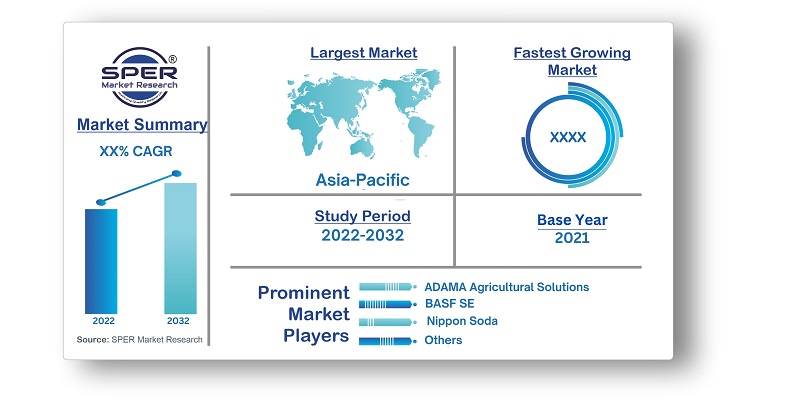
Australia Crop Protection Chemicals Market Growth, Size, Share, Trends and Future Opportunities
Australia Crop Protection Market Size- By Origin, By Type, By Application- Regional Outlook, Competitive Strategies and Segment Forecast to 2032
| Published: Mar-2023 | Report ID: AGRI2313 | Pages: 1 - 102 | Formats*: |
| Category : Agriculture | |||


| Report Metric | Details |
| Market size available for years | 2019-2032 |
| Base year considered | 2021 |
| Forecast period | 2022-2032 |
| Segments covered | By Origin, By Type, By Application. |
| Regions covered | New South Wales, Northern Territory, Queensland, South Australia, Tasmania, Victoria & Western Australia. |
| Companies Covered | ADAMA Agricultural Solutions, American Vanguard Corporation, BASF SE, Bayer CropScience AG, Bioworks Inc., Corteva Agriscience, FMC Corporation, Isagro Spa, Ishihara Sangyo Kaisha Ltd, Marrone Bio Innovations Inc., Nippon Soda, Nufarm Ltd, Sumitomo Chemicals, Syngenta International AG, UPL Limited. |
- Farmers
- Agricultural consultants
- Agrochemical companies
- Government agencies
- Research institutions
- Crop protection product distributors and retailers
- Investors and financial institutions
- Industry associations and trade organizations
- Academia and educational institutions
- Non-governmental organizations (NGOs) and environmental groups.
- Bio-based
- Synthetic
- Fungicide
- Herbicide
- Insecticide
- Molluscicide
- Nematicide
- Other Types
- Commercial Crops
- Fruits and Vegetables
- Grains and Cereals
- Pulses and Oilseeds
- Other Applications
- New South Wales
- Northern Territory
- Queensland
- South Australia
- Tasmania
- Victoria
- Western Australia
- Australia Crop Protection Chemicals Market Size (FY’2019-FY’2032)
- Overview of Australia Crop Protection Market
- Segmentation of Australia Crop Protection Market By Origin (Bio-based, Synthetic)
- Segmentation of Australia Crop Protection Pesticides Market By Type (Fungicide, Herbicide, Insecticide, Molluscicide, Nematicide, Other Types)
- Segmentation of Australia Crop Protection Market By Application (Commercial Crops, Fruits and Vegetables, Grains and Cereals, Pulses and Oilseeds, Other Applications)
- Statistical Snap of Australia Crop Protection Pesticides Market
- Growth Analysis of Australia Agrochemicals Market
- Problems and Challenges in Australia Crop Protection Market
- Competitive Landscape in the Australia Crop Protection Market
- Impact of COVID-19 and Demonetization on Australia Crop Protection Market
- Details on Recent Investment in Australia Agrochemicals Market
- Competitive Analysis of Australia Crop Protection Market
- Key Players in the Australia Crop Protection Pesticides Market
- SWOT Analysis of Australia Crop Protection Market
- Australia Agrochemicals Market Future Outlook and Projections (FY’2019-FY’2032)
- Recommendations from Analyst
1.1. Scope of the report1.2. Market segment analysis
2.1 Research data source2.1.1 Secondary data2.1.2 Primary data2.1.3 SPER’s internal database2.1.4 Premium insight from KOL’s2.2 Market size estimation2.2.1 Top-down and Bottom-up approach2.3 Data triangulation
4.1. Driver, Restraint, Opportunity and Challenges analysis4.1.1 Drivers4.1.2 Restraints4.1.3 Opportunities4.1.4 Challenges4.2. COVID-19 Impacts of the Australia Crop Protection Market
5.1. SWOT analysis5.1.1 Strengths5.1.2 Weaknesses5.1.3 Opportunities5.1.4 Threats5.2. PESTEL analysis5.2.1 Political landscape5.2.2 Economic landscape5.2.3 Social landscape5.2.4 Technological landscape5.2.5 Environmental landscape5.2.6 Legal landscape5.3. PORTER’S five forces analysis5.3.1 Bargaining power of suppliers5.3.2 Bargaining power of Buyers5.3.3 Threat of Substitute5.3.4 Threat of new entrant5.3.5 Competitive rivalry5.4. Heat map analysis
6.1 Australia Crop Protection Manufacturing Base Distribution, Sales Area, Product Type6.2 Mergers & Acquisitions, Partnerships, Product Launch, and Collaboration in Australia Crop Protection Market
7.1 Bio-based7.2 Synthetic
8.1 Fungicide8.2 Herbicide8.3 Insecticide8.4 Molluscicide8.5 Nematicide8.6 Other Types
9.1 Commercial Crops9.2 Fruits and Vegetables9.3 Grains and Cereals9.4 Pulses and Oilseeds9.5 Other Applications
10.1 Australia Crop Protection Size and Market Share by Region (2019-2025)10.2 Australia Crop Protection Size and Market Share by Region (2026-2032)10.3 New South Wales10.4 Northern Territory10.5 Queensland10.6 South Australia10.7 Tasmania10.8 Victoria10.9 Western Australia
11.1 ADAMA Agricultural Solutions11.1.1 Company details11.1.2 Financial outlook11.1.3 Product summary11.1.4 Recent developments11.2 American Vanguard Corporation11.2.1 Company details11.2.2 Financial outlook11.2.3 Product summary11.2.4 Recent developments11.3 BASF SE11.3.1 Company details11.3.2 Financial outlook11.3.3 Product summary11.3.4 Recent developments11.4 Bayer CropScience AG11.4.1 Company details11.4.2 Financial outlook11.4.3 Product summary11.4.4 Recent developments11.5 Bioworks Inc.11.5.1 Company details11.5.2 Financial outlook11.5.3 Product summary11.5.4 Recent developments11.6 Corteva Agriscience11.6.1 Company details11.6.2 Financial outlook11.6.3 Product summary11.6.4 Recent developments11.7 FMC Corporation11.7.1 Company details11.7.2 Financial outlook11.7.3 Product summary11.7.4 Recent developments11.8 Isagro Spa11.8.1 Company details11.8.2 Financial outlook11.8.3 Product summary11.8.4 Recent developments11.9 Ishihara Sangyo Kaisha Ltd11.9.1 Company details11.9.2 Financial outlook11.9.3 Product summary11.9.4 Recent developments11.10 Marrone Bio Innovations Inc.11.10.1 Company details11.10.2 Financial outlook11.10.3 Product summary11.10.4 Recent developments11.11 Nippon Soda11.11.1 Company details11.11.2 Financial outlook11.11.3 Product summary11.11.4 Recent developments11.12 Nufarm Ltd11.12.1 Company details11.12.2 Financial outlook11.12.3 Product summary11.12.4 Recent developments11.13 Sumitomo Chemicals11.13.1 Company details11.13.2 Financial outlook11.13.3 Product summary11.13.4 Recent developments11.14 Syngenta International AG,11.14.1 Company details11.14.2 Financial outlook11.14.3 Product summary11.14.4 Recent developments11.15 UPL Limited11.15.1 Company details11.15.2 Financial outlook11.15.3 Product summary11.15.4 Recent developments
SPER Market Research’s methodology uses great emphasis on primary research to ensure that the market intelligence insights are up to date, reliable and accurate. Primary interviews are done with players involved in each phase of a supply chain to analyze the market forecasting. The secondary research method is used to help you fully understand how the future markets and the spending patterns look likes.
The report is based on in-depth qualitative and quantitative analysis of the Product Market. The quantitative analysis involves the application of various projection and sampling techniques. The qualitative analysis involves primary interviews, surveys, and vendor briefings. The data gathered as a result of these processes are validated through experts opinion. Our research methodology entails an ideal mixture of primary and secondary initiatives.



Frequently Asked Questions About This Report
PLACE AN ORDER
Year End Discount
Sample Report
Pre-Purchase Inquiry
NEED CUSTOMIZATION?
Request CustomizationCALL OR EMAIL US
100% Secure Payment






Related Reports
Our Global Clients
Our data-driven insights have influenced the strategy of 200+ reputed companies across the globe.






















